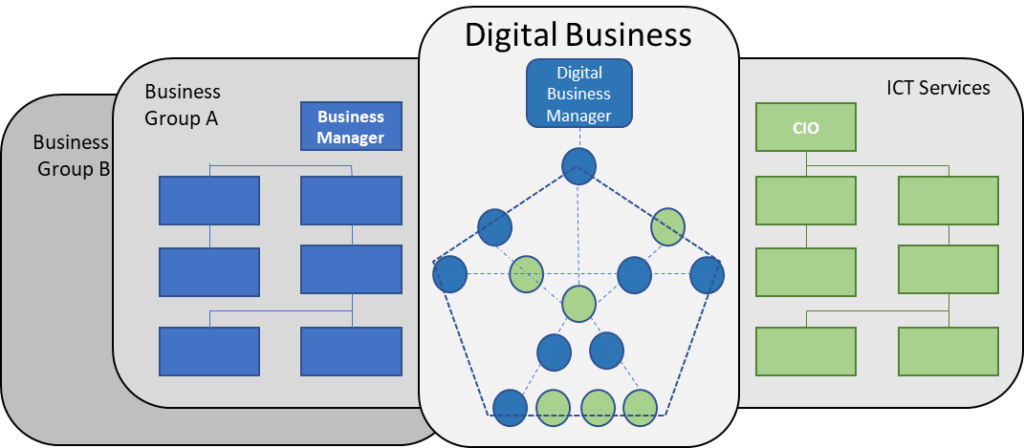Crossing the ICT / Digital Divide

Setting the Scene for Crossing the ICT/Digital Divide
I’m about to tread on potentially hallowed ground when I pose the question: “Is there really any difference between ICT and Digital? For this I offer no apology. Do you need an ICT Strategy, a Digital Strategy or both? Or, are they indeed one and the same? Must organisations insist on having a feud between marketing, customer service and ICT to determine who gets to the front seat on the road to digital?
‘Digital’ has polarised much of the ICT establishment from traditional systems engineers, to waterfall analysts/developers, through to strategists and architects. Yes, I use the term ‘engineers’ provocatively but not to incite another squabble (at his time)!
Being Digital, according to Mckinsey [1], “requires being open to re-examining your entire way of doing business and understanding where the new frontiers of value are”. Perhaps this suggests that being Digital is not really about technology at all? That being the case, there is undoubtedly a dilemma that still needs to be resolved.
Exploring the depth of ‘Digital’
In his book “The Digital Transformation Playbook: Rethink Your Business for the Digital Age[2]”, David L Rodgers introduces “the Five domains of Digital Transformation”, being Customers, Competition, Value, Innovation and Data. This, in itself suggests that ‘Digital’ is more than just ICT. The more you delve into it, the more you become aware that it is the association with business, i.e. Digital Business that starts to define its true scope.
Now, when you refer to Digital you can relate to business disruption and new business models, to building customer networks, and developing a data strategy. It is concerned with creating customer value (i.e. establishing a customer value proposition) and mapping the customers’ ‘path to purchase’. There is even possibly stronger correlation with marketing than there is with ICT!
The term ‘Digital Technologies’ has also become fashionable. In November 2019, Gartner highlighted ‘5 Digital Technology Trends for 2020’[3]. Does this create another potential wedge between the ICT and Digital camps? This article also suggests that “CIOs must understand how people interact with and experience digital technology along with understanding the technology itself”. Surely not another hat for CIOs to wear?
Noun, or Adjective I In an article by Mark Smalley “The Difference Between Digital Transformation & IT Transformation” he [4]points out that ‘IT or ICT’ is a noun (i.e. such as a person, place, or thing)”. It can include IT/ICT people, data centres, networks and equipment including hardware, software, data, and applications. He continues to say, ‘Digital’ is an adjective in the sense that it describes a person, place, or thing. If you accept this, it could be that the two terms are in fact complimentary with Digital describing both the ICT and the Business environments in which they coexist.

In the ICT context, Digital describes the blend of people, PCs, laptops, tablets and smartphones, data, applications and network. When aligned with business, (as in Digital Business), it refers to the processes and self-service that have been enabled by IT and the automation of the customer experience. I suggest that it only becomes an issue when people start to use ‘Digital’ as a noun and substitute it for the term ‘ICT or IT’.
The traditional ICT perspective
Some see ‘digital’ as the new era for ICT, whereas others see it as a sandpit in which those casually dressed can play with flashy toys and pretend to be real ICT people. The customers for ICT are generally the business users and Department Heads – the custodians of oversized and monolithic legacy applications and ERPs. Some might say that the distance between the ICT Department and the ‘real’ customers provides the justification for establishing a ‘digital intermediary’. Gartner has coined the term bimodal[5] in a move to accommodate such a notion.
Ironically, the term ‘luddites’ might best fit the ICT faction that is resistant to the emergent digital freight train? The term ‘Neo-Luddism’ is defined in Wikipedia as “a leaderless movement of passive resistance to consumerism and the increasingly bizarre and frightening technologies of the Computer Age.”[6] Believe it or not, this may appropriately describe a faction of traditional ICT workers’ posture on the use of the term “Digital”.
Do they see it as a threat? More likely they see it as a natural career step that is being denied by the business in an attempt to knuckle-in on their rightful domain. ICT Traditionalists would typically specialise in CRMs, ERPs and relational databases, Spatial and GIS systems, data warehouses and data lakes, MS 365 and Teams – i.e. mainstream ICT (part of the conventional ICT skill set).

The Digital Evangelists perspective
The ‘Digital Community’ generally comprises Digital business pacesetters, agile design thinkers as well as ‘online window-shoppers’ (i.e. customers).
Frequently, they emerge from customer service areas or marketing where the passion for end-customer service excellence is already interwoven in their psyche. They undoubtedly mean well.
Digital is synonymous with agile and iterative development, design thinking and co-design, cloud computing and DevOps, being adaptive and collaborative. Its underlying philosophy is about speed to market, personalisation and enhancing customer’/user’ experience. Its typical technology portfolio encompasses digital sensors and IoT, AI and machine learning, Social media and data analytics, cryptocurrency, Digital Twins and 5G i.e. alternative ICT (these skills are outside the traditional ICT skill set).
What are the common capabilities?
A key to resolving any conflict will be through Business Architecture. This will consider business stakeholders and processes, capabilities and value streams, customer journey and value maps as a basis to construct a blueprint of the target business and to highlight gaps and expected outcomes of improvement and transformation initiatives. The artefacts produced will overlay the applications, data/information and technology architectures to provide a complete enterprise model. Business architecture skills can be learned and practised by representatives of the business. This will help to legitimise the role of architecture in organisation development.
Structurally, this might be represented as figure one below suggests, with a mixture of fixed and virtual product teams in some form of Digital Business Centre of Excellence (CoE).

Other capabilities that can readily be acquired by the business include design thinking, business analytics, agile and iterative project skills, business analysis, experimentation and testing. In line with this, a lighter flavour of governance, for distributed initiatives, should be prescribed to minimise delays and eliminate unnecessary red tape. Of course, the ICT specialists still have a critical role to play in providing architectural and technical nous to underpin and deliver the initiatives.
So, what might we conclude?

Firstly, we need to keep in mind that ‘industry’ tends to amplify those things that sell new products and services. For comparison, consider the millions of dollars that businesses sunk into Y2K consultancies and the question arises – Is the Post COVID-19 scenario threatening to ignite the same? The Digital advent too is one of those events. That being said:
- ICT is an umbrella term that encompasses people, processes, hardware, software, applications, methods, and tools. ICT and Digital are not synonymous terms, but they are contiguous and complimentary. Digital can describe the operations of a business, an ICT environment, or a category of technology. Its remit extends beyond ICT into business operating models and industry reshaping as well as formulating new customer experiences.
- The failure of organisations to optimise digital and ICT productivity is costing them substantially in lost productivity and missed opportunities.
- A Digital strategy can form an adjunct to an ICT strategy, and both should be derived from and be embedded as a by-product of business strategy formulation.
- Business Architecture is the missing link in modelling the complete blueprint for the modern ‘adaptive’ enterprise.
- Organisations must resolve their approach to ICT and Digital, for business sake.
Recommendations
The extent to which these recommendations will apply to your organisation depends on the level of maturity you’ve already reached. However, all are worthy of consideration.
- Established a Business Architecture Centre of Excellence (CoE) comprising both ICT Enterprise Architects (EAs) and business Subject Matter Experts (SMEs). This should be led or mentored by an experienced Senior or Chief Architect (given the depth of knowledge and understanding involved).
- A Digital strategy can form an adjunct to an ICT strategy, and both should be embedded as a by-product of business strategy development.
- Organisations should establish business-led product teams with core capabilities coming from ICT and business areas with a strong transformational mandate. An appropriate ‘lite’ governance model should be applied to maximise pace and eliminate obstacles.
Yes, the implications include that of reshaping the traditional ICT organisation to establish a hybrid Digital Business function that will coexist and collaborate to generate increased business value.
Thanks for taking time out to read this piece. Please feel free to offer your own perspective and opinions on this emotive subject.
About the Author
Tony Welsh started his ICT career in the UK in retail banking. He moved as a Senior Consultant with LBMS (London) to join KPMG in New Zealand and subsequently to the position of ICT Director (CIO) at Wellington City Council. He moved with his family to Australia in late 1999 to commence as GM Information Services (CIO) for Queensland Rail and he subsequently spent 6 years as CIO for Brisbane City Council (BCC) the then largest Council in the Southern Hemisphere. Tony most recently completed 16 months as the Interim CIO for Ipswich City Council in Queensland.
CIOco is available for short and long term engagements and for advisory services and we can be contacted on +61 407 025 750 or at Tony.Welsh@CIOco.com.au or via our website at https://CIOco.com.au
[1] https://www.mckinsey.com/industries/technology-media-and-telecommunications/our-insights/what-digital-really-means#
[2] Title: The digital transformation playbook: rethink your business for the digital age by David L. Rogers New York: Columbia University Press, [2016]
[3] https://www.gartner.com/smarterwithgartner/5-digital-technology-trends-for-2020/
[4] https://blog.goodelearning.com/subject-areas/it4it/the-difference-between-digital-transformation-it-transformation/
[5] Bimodal is the practice of managing two separate but coherent styles of work: one focused on predictability; the other on exploration.
[6] Sale, Kirkpatrick (1 February 1997). “America’s New Luddites”. Le Monde diplomatique. Archived from the original on 30 June 2002.
